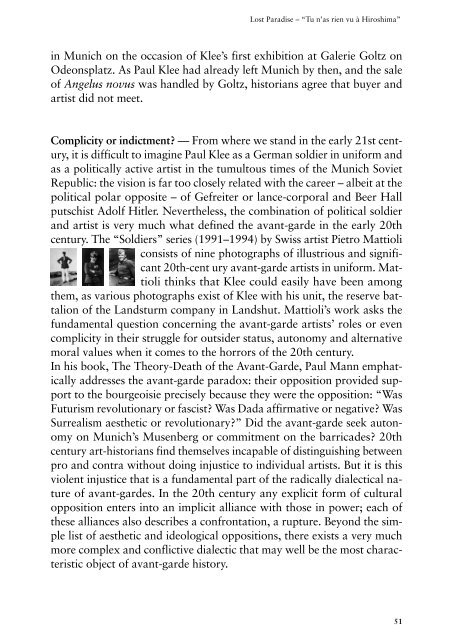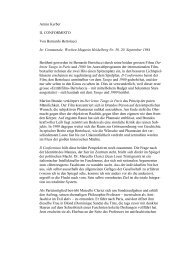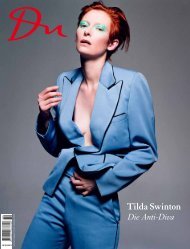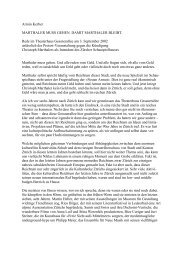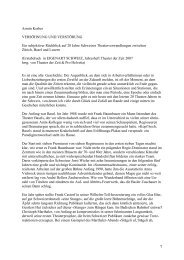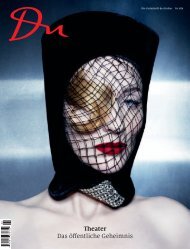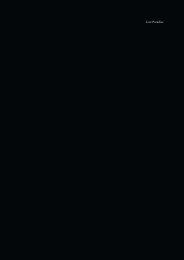You also want an ePaper? Increase the reach of your titles
YUMPU automatically turns print PDFs into web optimized ePapers that Google loves.
<strong>Lost</strong> <strong>Paradise</strong> – “Tu n’as rien vu à Hiroshima”<br />
in Munich on the occasion of Klee’s first exhibition at Galerie Goltz on<br />
Odeonsplatz. As Paul Klee had already left Munich by then, and the sale<br />
of Angelus novus was handled by Goltz, historians agree that buyer and<br />
artist did not meet.<br />
Complicity or indictment? — From where we stand in the early 21st century,<br />
it is difficult to imagine Paul Klee as a German soldier in uniform and<br />
as a politically active artist in the tumultous times of the Munich Soviet<br />
Republic: the vision is far too closely related with the career – albeit at the<br />
political polar opposite – of Gefreiter or lance-corporal and Beer Hall<br />
putschist Adolf Hitler. Nevertheless, the combination of political soldier<br />
and artist is very much what defined the avant-garde in the early 20th<br />
century. The “Soldiers” series (1991–1994) by Swiss artist Pietro Mattioli<br />
consists of nine photographs of illustrious and significant<br />
20th-cent ury avant-garde artists in uniform. Mattioli<br />
thinks that Klee could easily have been among<br />
them, as various photographs exist of Klee with his unit, the reserve battalion<br />
of the Landsturm company in Landshut. Mattioli’s work asks the<br />
fundamental question concerning the avant-garde artists’ roles or even<br />
complicity in their struggle for outsider status, autonomy and alternative<br />
moral values when it comes to the horrors of the 20th century.<br />
In his book, The Theory-Death of the Avant-Garde, Paul Mann emphatically<br />
addresses the avant-garde paradox: their opposition provided support<br />
to the bourgeoisie precisely because they were the opposition: “Was<br />
Futurism revolutionary or fascist? Was Dada affirmative or negative? Was<br />
Surrealism aesthetic or revolutionary?” Did the avant-garde seek autonomy<br />
on Munich’s Musenberg or commitment on the barricades? 20th<br />
century art-historians find themselves incapable of distinguishing between<br />
pro and contra without doing injustice to individual artists. But it is this<br />
violent injustice that is a fundamental part of the radically dialectical nature<br />
of avant-gardes. In the 20th century any explicit form of cultural<br />
opposition enters into an implicit alliance with those in power; each of<br />
these alliances also describes a confrontation, a rupture. Beyond the simple<br />
list of aesthetic and ideological oppositions, there exists a very much<br />
more complex and conflictive dialectic that may well be the most characteristic<br />
object of avant-garde history.<br />
51


